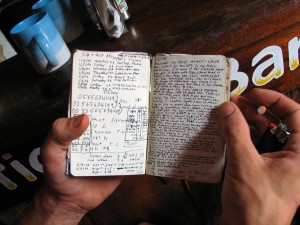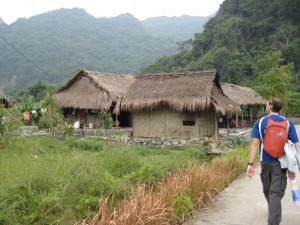The Struggle of Trip-Planning & The Creation of UnAnchor
by Jason -- November 23, 2010
 During our year-long trip, Sharon and I planned our tourist sight-seeing days in many different ways. We used “Lonely Planet” guidebooks, “Eyewitness” guidebooks, Wikitravel.org, local tourism brochures, and numerous other online resources. All of these resources were helpful, but none of them solved the planning process effectively. “Lonely Planet’s” recommendations were hit and miss in terms of quality, many of the websites seemed like advertisements and many others gave incomplete or outdated information.
During our year-long trip, Sharon and I planned our tourist sight-seeing days in many different ways. We used “Lonely Planet” guidebooks, “Eyewitness” guidebooks, Wikitravel.org, local tourism brochures, and numerous other online resources. All of these resources were helpful, but none of them solved the planning process effectively. “Lonely Planet’s” recommendations were hit and miss in terms of quality, many of the websites seemed like advertisements and many others gave incomplete or outdated information.
In the travel planning process, there are three primary problems that still have not been solved sufficiently:
- When visiting a new city, it’s too difficult and time-consuming to choose the sights to see amongst all of the options.
- Directions aren’t specific enough and not enough maps are given.
- Determining the best way to travel between two cities is too difficult and time-consuming.
Seeing these issues arise time and time again and talking with fellow travelers led me to realize the potential business opportunity of solving these problems. In the following post, I’ll discuss how my startup, UnAnchor, will solve the first two problems and may one day also solve the third.
1. Prioritizing Sights is Too Difficult
The Problem: When Sharon and I had 1 to 3 days in a new city, trying to choose what sights to see reminded me of walking into the cheese aisle at a grocery store — everything looks good, there are way too many to choose from and there is hardly any information. Most guidebooks give travelers two sentence descriptions for 30 historical landmarks and then expect you to choose a couple to see. I hate this process.
Why UnAnchor Solves It: A self-guided tour itinerary prioritizes the sights and attractions for the traveler based on how much time they have in a given city. Rather than forcing the inexperienced traveler to choose from a two-sentence description, an expert chooses for them.
Example: Beijing, China. It’s a HUGE city with a ridiculous amount of things to do. Using our “Lonely Planet” guidebook to try and choose the sights and attractions we were going to see was painful. Everything sounded great. Thankfully, because we were there for 10 days we got to see quite a few sights, but if I were only there for a couple days it would have been really tough to choose. After seeing a number of the sights, they were all good. A traveler isn’t going to be disappointed by having sights prioritized for them, they will be relieved by not having to go through the process of choosing sights.
2. Directions Aren’t Clear Enough
The Problem: Getting around a new city is really difficult. Knowing what bus stop to get off at or which subway to take is not enough information to find your way. Unfortunately, this is the extent most websites and guide books go.
Why UnAnchor Solves It: The directions are specific, clear and unambiguous. They include the necessary turns to make, the signs to look out for, and often include pictures and maps.
Why I think this will work: To be honest I believe this is a good interim solution. It’s still better than 95% of what’s out there. But, the perfect solution is using a Smartphone with GPS guided directions. Including this type of feature is a future goal for UnAnchor.
3. Getting Between Two Cities Is Too Difficult
The Problem: Determining the most efficient way to travel between two cities is difficult and time-consuming. Do you take a bus? A train? Do you fly?
Example: We were in Beijing and wanted to get to South Korea. There were flights, but they were very expensive because we had not booked in advance. Thankfully, there were a lot of ferry options; unfortunately though, there were too many ferry options. They departed from a few different cities and the amount of time they took to get to Korea varied significantly. Another factor that needed to be considered was the amount of money and time it took to get to the ferry’s departure city from Beijing.
Why UnAnchor Will Not Solve This Problem: Theoretically, one could write an itinerary detailing out the best way to get from Beijing to South Korea to solve my example. However, we’re not planning on initially focusing UnAnchor around this issue, nor is that a very scalable solution. A more elegant solution would be similar to Google Maps implementation of public transportation directions — laying out the various options while factoring in time and cost.
 Bringing It All Together – My “Ah-ha” moment
Bringing It All Together – My “Ah-ha” moment
I had been experiencing these problems regularly. I grew frustrated, but continued to find ways around them. It took a day of hiking on Cat Ba Island in Halong Bay, Vietnam to have my UnAnchor “ah-ha” moment.
There’s a famous national park featuring a popular hike on Cat Ba Island. Sharon and I were both interested in doing the hike, but every time we tried to find information about the hike or ask for a map of the park, the only thing people wanted to do was sell us an overpriced tour guide.
 Determined to find another way, I spent a number of hours researching the hike. I found people online who said it was a nice and a reasonably easy hike, but despite my efforts, I was unable to find a map or anyone with detailed instructions on doing the hike. Eventually, Sharon and I just decided to do it on our own, map-less. We caught a motorbike taxi, found a boat to take us to the trailhead and headed off into the park. We got a late start, but headed out regardless. We hiked through a beautiful village and then eventually through some thick foliage. We began getting concerned and after realizing at one point that we had walked in multiple circles, we decided to give up and head back. While I was disappointed we didn’t get to complete the hike, I was proud of us for giving it a shot.
Determined to find another way, I spent a number of hours researching the hike. I found people online who said it was a nice and a reasonably easy hike, but despite my efforts, I was unable to find a map or anyone with detailed instructions on doing the hike. Eventually, Sharon and I just decided to do it on our own, map-less. We caught a motorbike taxi, found a boat to take us to the trailhead and headed off into the park. We got a late start, but headed out regardless. We hiked through a beautiful village and then eventually through some thick foliage. We began getting concerned and after realizing at one point that we had walked in multiple circles, we decided to give up and head back. While I was disappointed we didn’t get to complete the hike, I was proud of us for giving it a shot.
It was during this hike, I had my “ah-ha” moment and realized the potential for self-guided tour itineraries. Having a 1-day self-guided itinerary for a hike through the National Park would have been perfect. I gladly would have paid a few bucks for it.
What do you think?
Have you experienced these same issues? Do you agree with my findings? What other problems have you had while traveling that you think need to be solved?
Photo Credits: Moleskine, Lightbulb
Be awesome and help us share:

I’ve definitely experienced similar issues and over time I’ve just decided that when it becomes such a challenge the best way to see the place is to just wander and get lost. Who cares about a map! The best things are always a surprise.
Organizing information is the goal of the web, but in most cases there is too much information or too many advertising sites it is hard to separate the wheat from the chaff.
When we went to Chiapas we had no idea how to get where we needed to go. We found no help online, but massive help on the ground.
Your site will definitely save time, which is money, and I can’t wait to see it take off